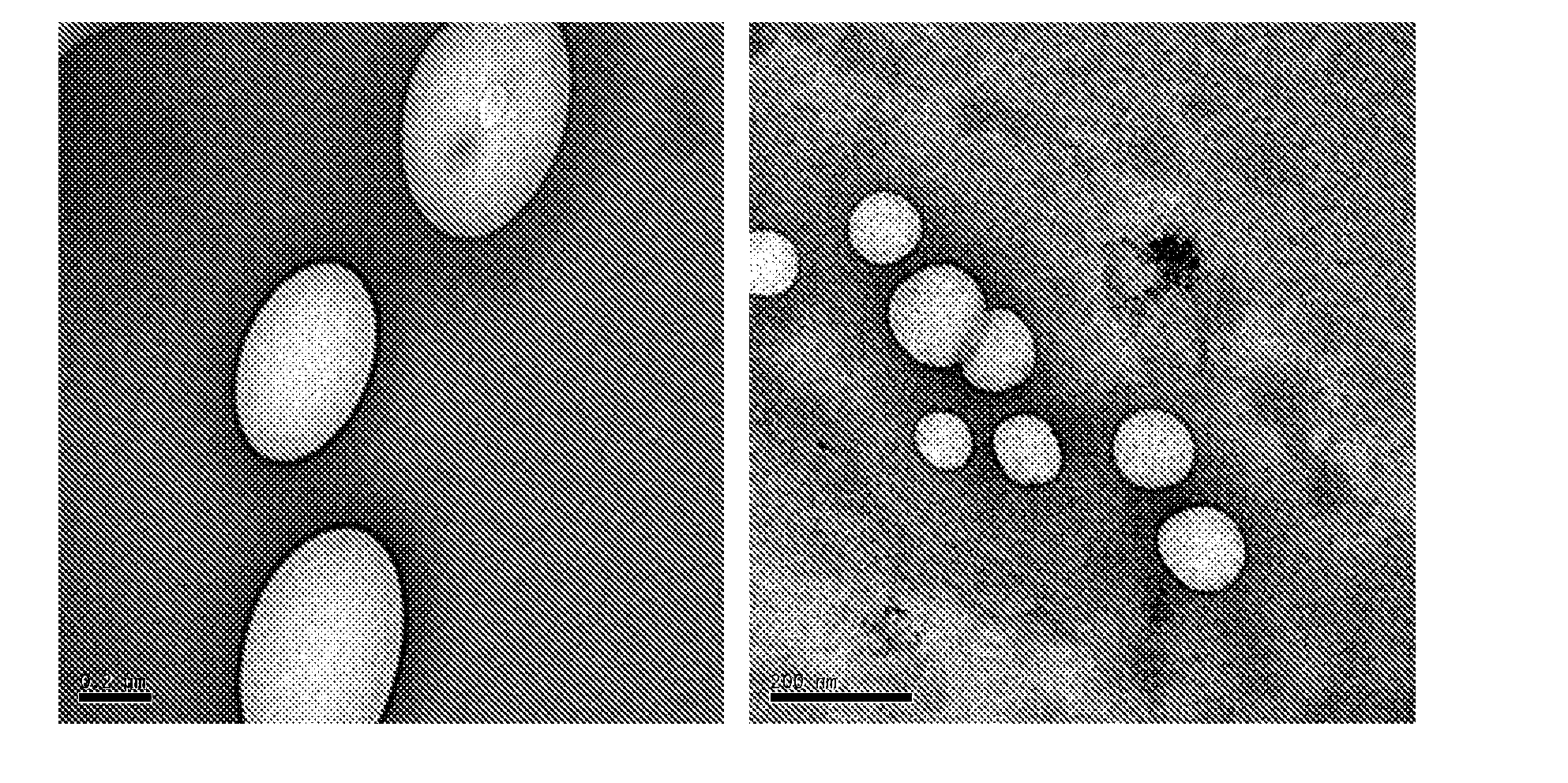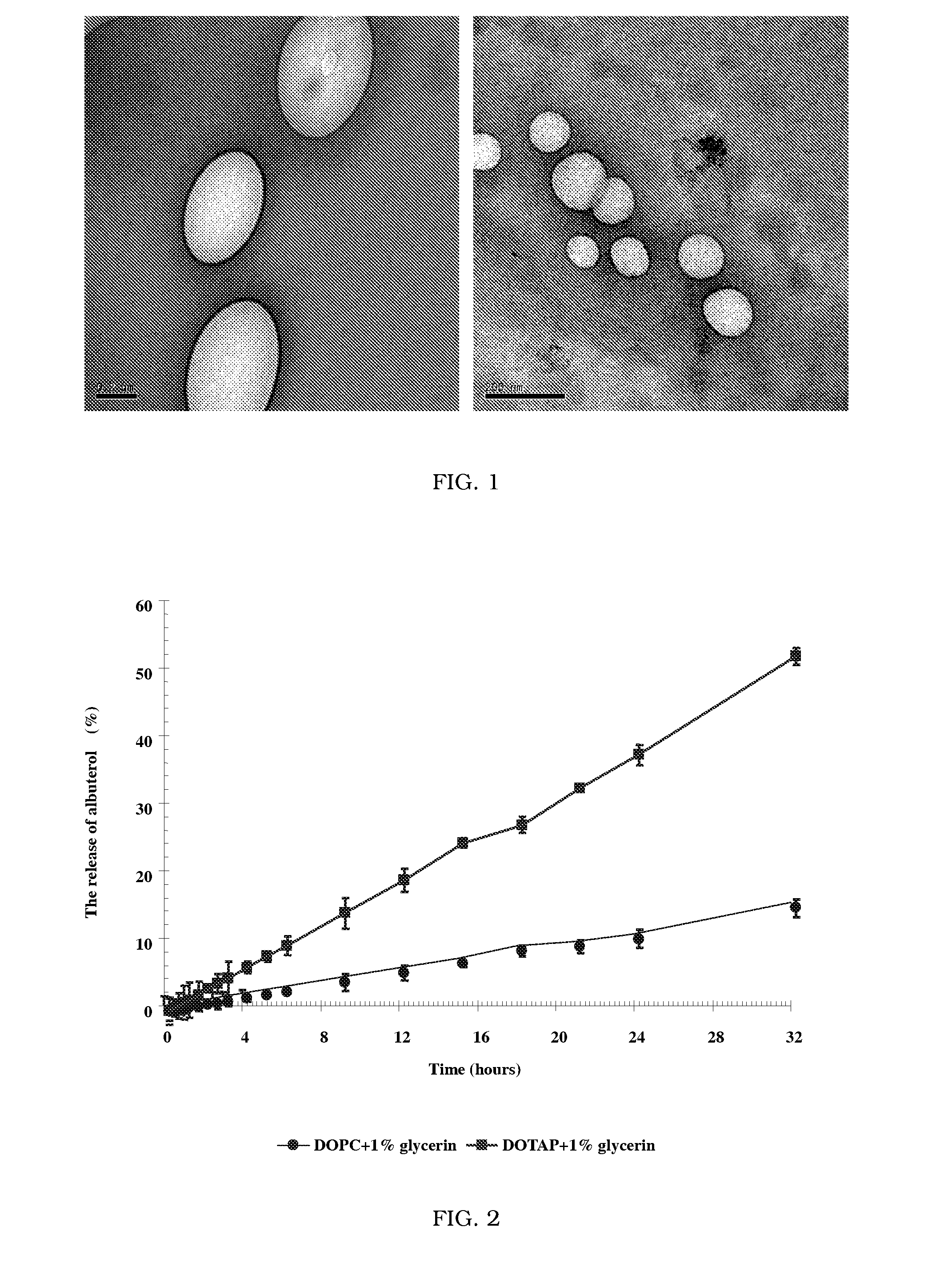Novel formulation of dehydrated lipid vesicles for controlled release of active pharmaceutical ingredient via inhalation
a technology of lipid vesicles and inhalation, which is applied in the direction of drug compositions, aerosol delivery, spray delivery, etc., can solve the problems of asthma often not being treated with the right kind coughing, wheezing, etc., and achieves effective controllable potency of active pharmaceutical ingredient, reduce toxicity and systemic side effects, and controllable particle siz
- Summary
- Abstract
- Description
- Claims
- Application Information
AI Technical Summary
Benefits of technology
Problems solved by technology
Method used
Image
Examples
example 1
[0300]Preparation of Liposomes By Thin Film Hydration
[0301]Aqueous multilamellar vesicles (MLV) were prepared by conventional lipid membrane hydration method and subsequent small unilamellar vesicles (SUV) were produced by extrusion. Lipid and albuterol were dissolved in chloroform and methanol respectively, and then the solutions were mixed with the indicated molar ratios of lipid and albuterol. The mixture was dried into a homogeneous lipid membrane under a stream of nitrogen gas, and then under vacuum overnight to remove any residual organic solvents. This lipid membrane was hydrated in 10 mM Tris-buffered isosmotic saline buffer solution (10 mM Tris, 137 mM sodium chloride, and pH 7.4 at 25° C.). The final concentration of the lipid was controlled at 5˜20 mg / mL. Then the mixture was maintained at 80° C. (over the transition temperatures of all lipids) for 60 minutes to anneal the liposome structure. During annealing, it was stirred 3 times with vortex at the beginning, middle, a...
example 2
[0304]Preparation of Liposomes by Solvent Injection Technique
[0305]A mixture of partially DOPC or DOTAP, and active pharmaceutical ingredient (albuterol, 0.04 mmol) in the mole ratio of 1:2 was dissolved in 4 ml of ethanol. Liposomal albuterol dispersion was formed by injecting the lipid / active pharmaceutical ingredient / ethanol solution into 50 ml of the phosphate buffered saline pH 7.4. Liposomes thus formed were extruded through a 0.4 or a 0.2 μm polycarbonate membrane to produce uniform size liposome vesicles distribution.
[0306]Determination of Encapsulation Efficiency
[0307]150 μL of freshly prepared liposomal sample was centrifuged with an Avanti J-E centrifuge (type JA-20, 17400×g, 6° C., and 20 min) through Microcon Y-10 Centrifugal Filter Devices (Millipore) with a cut-off value of 10,000 Dalton. The concentration of albuterol in the centrifuged solution was determined spectrophotometrically at 276 nm. This concentration represented the concentration of albuterol in the conti...
example 3
[0308]Preparation of Liposomes by Vesicular Phospholipid Gels.
[0309]1 ml of albuterol saturated water, 0.1 g of glycerin and 2 g of SPC was mixed by high speed homogenizer under 50° C. till forming gels; and then the gels diluted in 100 ml of the phosphate buffered saline pH 7.4 to form the liposome vesicles.
[0310]Determination of Encapsulation Efficiency 150 μL of freshly prepared liposomal sample was centrifuged with an Avanti J-E centrifuge (type JA-20, 17400×g, 6° C., and 20 min) through Microcon Y-10 Centrifugal Filter Devices (Millipore) with a cut-off value of 10,000 Dalton. The concentration of albuterol in the centrifuged solution was determined spectrophotometrically at 276 nm. This concentration represented the concentration of albuterol in the continuous phase of the liposome (non-encapsulated albuterol). The spectrophotometrical method was also used with the determining of the total concentration of albuterol including in the dispersed phase and the continuous phase of ...
PUM
| Property | Measurement | Unit |
|---|---|---|
| Fraction | aaaaa | aaaaa |
| Fraction | aaaaa | aaaaa |
| Fraction | aaaaa | aaaaa |
Abstract
Description
Claims
Application Information
 Login to View More
Login to View More - R&D
- Intellectual Property
- Life Sciences
- Materials
- Tech Scout
- Unparalleled Data Quality
- Higher Quality Content
- 60% Fewer Hallucinations
Browse by: Latest US Patents, China's latest patents, Technical Efficacy Thesaurus, Application Domain, Technology Topic, Popular Technical Reports.
© 2025 PatSnap. All rights reserved.Legal|Privacy policy|Modern Slavery Act Transparency Statement|Sitemap|About US| Contact US: help@patsnap.com


